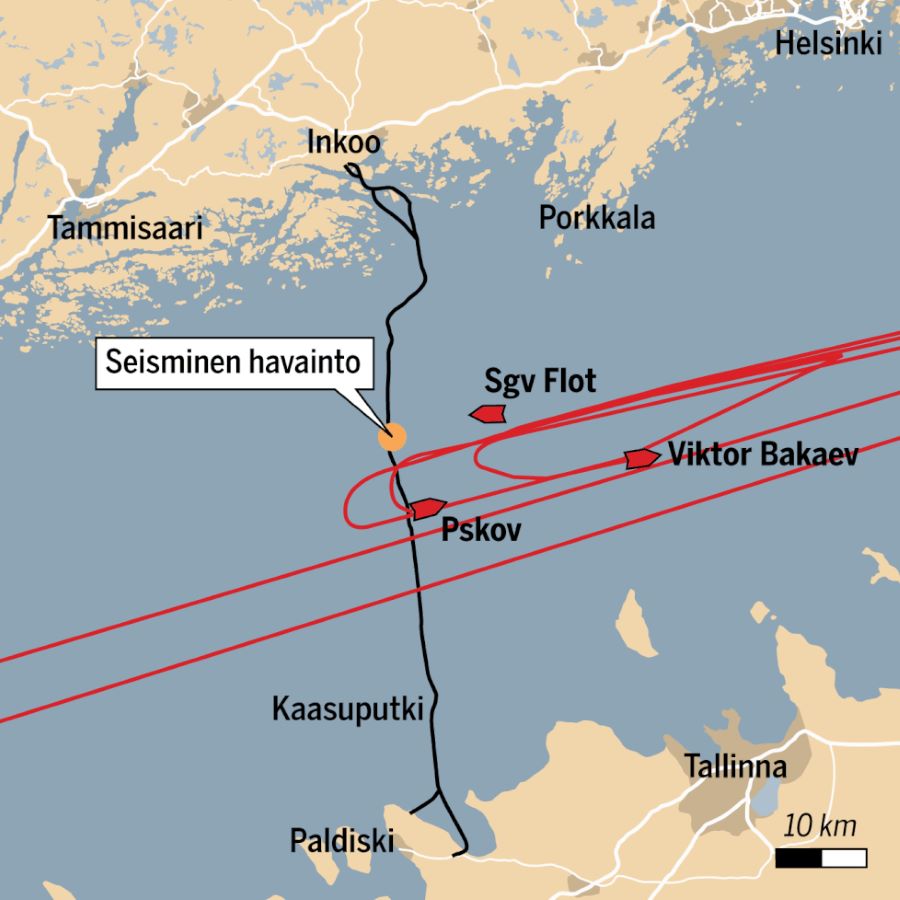Who damaged the undersea gas and telecom links between Finland and Estonia?
Approximately one year after an incident involving the sabotage of the Nord Stream gas pipeline, officials from Finland and Estonia are investigating damage to an undersea gas pipeline and telecommunications cable that appears to be the result of "external activity."
Finland's National Bureau of Investigation launched an inquiry into the incidents, along with its Estonian counterparts. Both countries informed the NATO headquarters and the European Union on the matter.
The Finnish government reported the damage earlier this week, which affected the BalticConnector gas pipeline following an unexplained drop in pressure over the weekend, prompting its shutdown.
Finnish Prime Minister Petteri Orpo refrained from labeling the damage as an act of sabotage but emphasized that it could not have resulted from routine operations.
“According to a preliminary assessment, the observed damage could not have occurred as a result of normal use of the pipe or pressure fluctuations. It is likely that the damage is the result of external activity,” Orpo stated.
When asked if the Finnish government suspected Russian involvement, Orpo declined to speculate and asked the public to wait for the results of the ongoing investigation.
Additionally, the Finnish telecoms operator Elisa confirmed a breach in a data cable connecting Finland and Estonia over the same weekend.
Estonian Prime Minister Kaja Kallas said both countries took these incidents very seriously and were actively seeking to determine the circumstances surrounding the damage.
She noted that the government in Riga helped stabilize the situation: “Thanks to our own resources and connections with Latvia, gas supplies of Estonia are ensured.”
According to Estonian Defense Minister Hanno Pevkur, the damaged cable and pipeline are located in different places, despite the close timing of the incidents.
The Estonian authorities have received photos confirming that the damage to the BalticConnector was "mechanical" and "human-made."
Any Russian vessels in the area?
No explosion had been involved at the gas pipeline or telecom cable as seismologists ruled out such a possibility based on their records during the time of the pressure loss.
The Finnish outlet Ilta-Sanomat reported an “unusual” movement of vessels maneuvering near the gas pipeline ahead of the incidents.
“There were a lot of ships in the area during the weekend. However, most were on a transit trip. A few ships stayed around the area for a long time, for example the Liberian-registered tankers Pskov and Viktor Bakaev,” a Google translation from the website IS.fi reads.
According to the position information provided by the Marinetraffic service, Pskov and Viktor Bakaev arrived in the area on Friday and sailed over the pipe towards the east. On Friday night they turned back west and circled near where the gas pipeline runs and turned back east. On Saturday they turned west again and went even closer to the pipe, the report goes on.
“Moments after the possible seismic detection, both vessels appear to have made a turn near where the gas pipeline passes. After that they turned back east again,” Ilta-Sanomat said.
The vessels’ names suggest Russian affiliation – Pskov is a city in Russia and Viktor Bakaev is the name of a Russian maritime researcher.

Unusual movements of two Russian tankers under Liberian flag. Credit: IS.fi
The portal Vesselfinder.com shows that the oil tanker Viktor Bakaev was in the Russian port of Ust-Luga on 9 October and was sailing near Denmark on 14 October. The same source shows that the Pskov vessel was still in the Baltic Sea as of Saturday.
The October incidents occurred a little over a year after the sabotage of the Nord Stream gas pipelines, which lie on the Baltic Sea bed between Germany and Russia. That case remains unsolved and investigators suspect that either Russian Navy special forces or Ukrainian specialist units are behind the attack.
The BalticConnector pipeline, spanning 77 kilometers and connecting the Finnish city of Inkoo to the Estonian port of Paldiski, began commercial operations in early 2020 and was primarily financed by the EU.
Following Russia's suspension of gas imports to Finland in May 2022, the BalticConnector has served as the only gas import channel, apart from LNG, as Finland had refused to pay in rubles, a condition imposed by Russia on "unfriendly countries."
Maritime-Executive cited last May NATO officials as warning of imminent Russian attacks against the undersea infrastructure of countries supporting Ukraine in the war unleashed by the Kremlin.
***
Feel free to support our small office: IBAN - RO50BTRLEURCRT0490900501, Swift - BTRLRO22, Beneficiary - Rudeana SRL.
Not feeling like donating? Then click on banners on our website to generate ad revenue. Any help is welcome.







